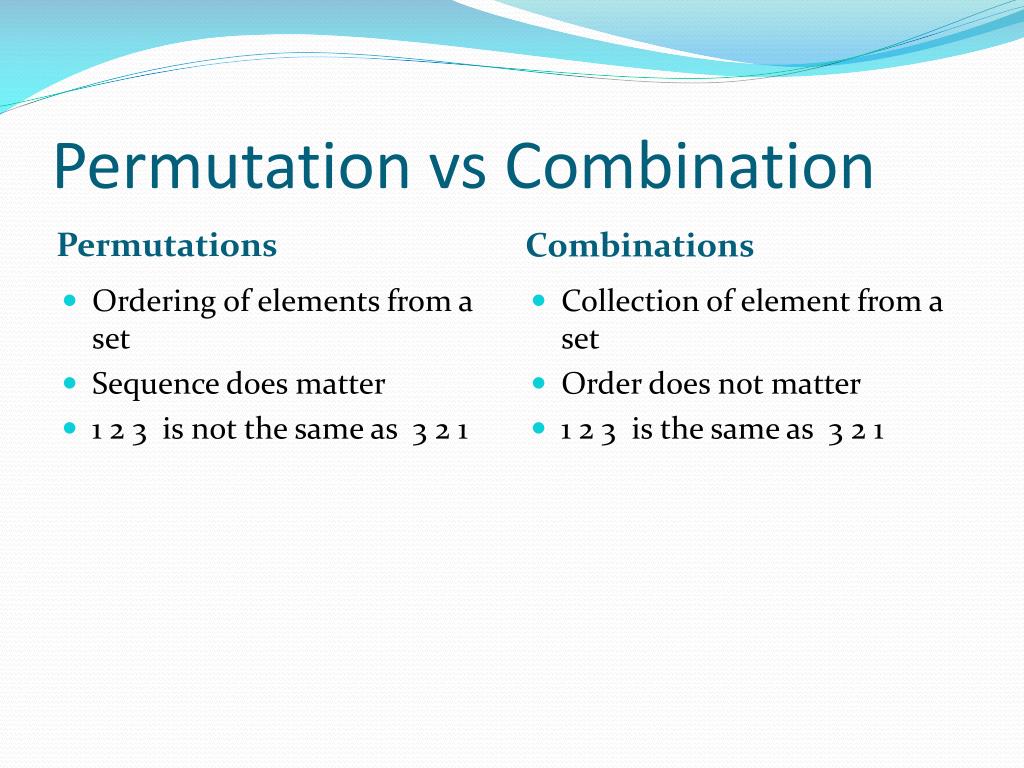
In example 1, the team (A B) is same as the team (B A).From 3 letters, A, B, and C, how many 2-digit words can be formed?ĭo both the examples looks same to you? From 3 players, A, B, and C, how many doubles team can be formed?Ģ. To clarify this confusion, let us understand two simple cases:ġ. In most of the p and c questions, we arrive at a point where we need to select or arrange a few things and many students fall prey to the same mistake of applying selection in place of arrangement and vice-versa. We will also provide few GMAT like practice questions to test the understanding.
#Permutation and combination how to#

Therefore the probability of winning the lottery is 1/13983816 = 0.000 000 071 5 (3sf), which is about a 1 in 14 million chance. The number of ways of choosing 6 numbers from 49 is 49C 6 = 13 983 816. What is the probability of winning the National Lottery? You win if the 6 balls you pick match the six balls selected by the machine.

In the National Lottery, 6 numbers are chosen from 49. The above facts can be used to help solve problems in probability. There are therefore 720 different ways of picking the top three goals. Since the order is important, it is the permutation formula which we use. In the Match of the Day’s goal of the month competition, you had to pick the top 3 goals out of 10. The number of ordered arrangements of r objects taken from n unlike objects is: How many different ways are there of selecting the three balls? There are 10 balls in a bag numbered from 1 to 10. The number of ways of selecting r objects from n unlike objects is: Therefore, the total number of ways is ½ (10-1)! = 181 440 How many different ways can they be seated?Īnti-clockwise and clockwise arrangements are the same. When clockwise and anti-clockwise arrangements are the same, the number of ways is ½ (n – 1)! The number of ways of arranging n unlike objects in a ring when clockwise and anticlockwise arrangements are different is (n – 1)! There are 3 S’s, 2 I’s and 3 T’s in this word, therefore, the number of ways of arranging the letters are: In how many ways can the letters in the word: STATISTICS be arranged? The number of ways of arranging n objects, of which p of one type are alike, q of a second type are alike, r of a third type are alike, etc is: The total number of possible arrangements is therefore 4 × 3 × 2 × 1 = 4! The third space can be filled by any of the 2 remaining letters and the final space must be filled by the one remaining letter. The second space can be filled by any of the remaining 3 letters. The first space can be filled by any one of the four letters. This is because there are four spaces to be filled: _, _, _, _ How many different ways can the letters P, Q, R, S be arranged?

The number of ways of arranging n unlike objects in a line is n! (pronounced ‘n factorial’).

This section covers permutations and combinations.


 0 kommentar(er)
0 kommentar(er)
